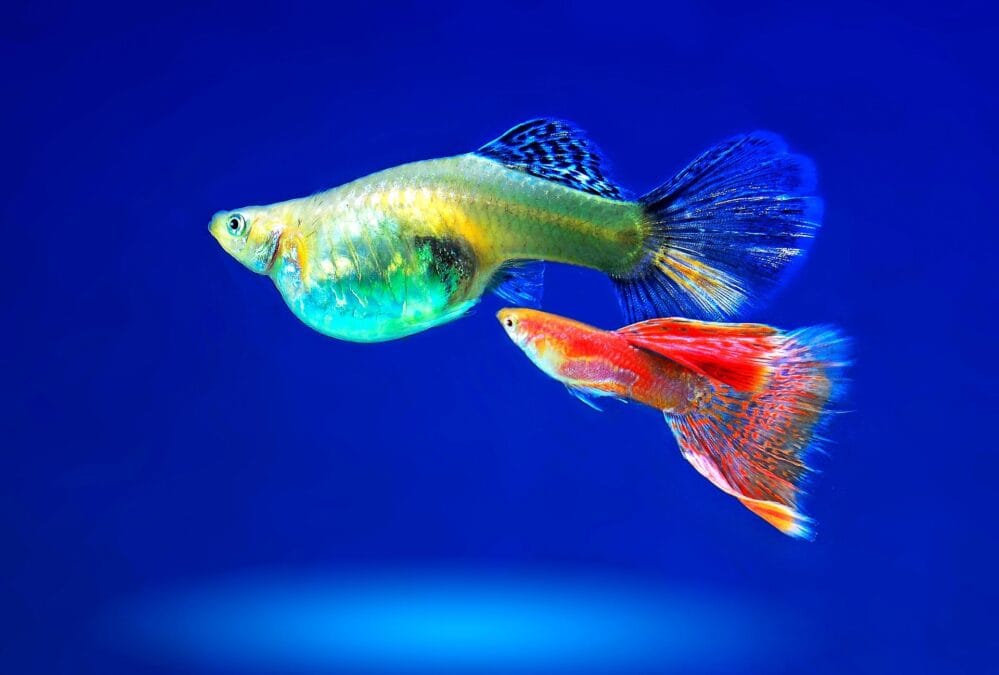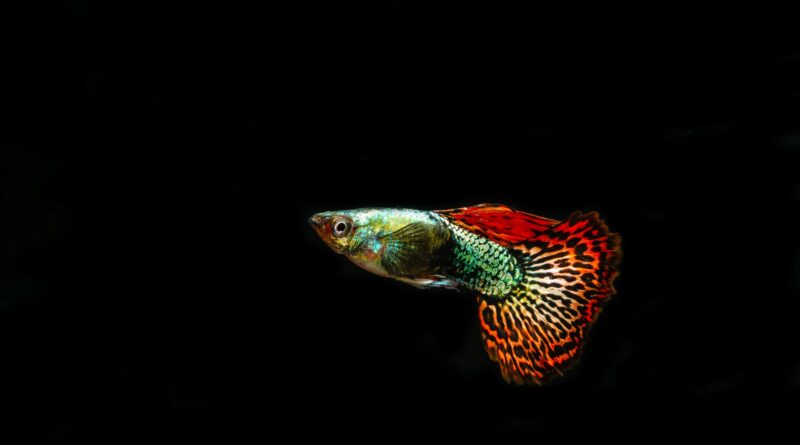Guppy (Poecilia reticulata) Care Guide: Tank Size, Water, Diet & Breeding
Guppy care is straightforward when you balance tank size, stable water parameters, temperature, a varied diet, and compatible tank mates. The guppy (Poecilia reticulata) is a hardy, colourful livebearer loved by beginners and breeders alike. Peaceful and endlessly active, it thrives in planted community tanks and adapts well to a range of water conditions—especially mineral-rich, stable setups. Because guppies are prolific, we include a streamlined Breeding Guide below to help you manage fry from day one. You’ll also find practical advice on tank size, water parameters, diet, and compatible tank mates so you can set up a healthy, low-stress guppy community.
Facts & Overview
| Attribute | Detail |
|---|---|
| Scientific Name | Poecilia reticulata |
| Class / Order / Family / Genus | Actinopterygii / Cyprinodontiformes / Poeciliidae / Poecilia |
| Common Name | Guppy, Millionfish |
| Origin / Habitat | Northern South America and Caribbean islands; inhabits slow-moving streams, ditches, and brackish coastal waters rich in vegetation |
| Lifespan | 2–3 years on average, occasionally longer in ideal conditions |
| Adult Size | Males up to 3.5 cm (1.4 in); females up to 5 cm (2 in) |
| Water Parameters | 23–28 °C (73–82 °F); pH 7.0–8.0; moderate-hard water (8–30 dGH) |
| Temperament | Peaceful, social livebearer; may display mild mating harassment |
| Swimming Level | Mid to top regions of the aquarium |
| Minimum Tank Size | 38 L / 10 gal for a small group (1 male : 2–3 females) |
| Care Level | Easy; tolerant and beginner-friendly |
Appearance
Shape & Colouration
Guppies have slender, torpedo-shaped bodies with a slightly upturned mouth and large, fan-like caudal fins that vary dramatically by strain. Males are vividly colored—metallic blues, reds, yellows, greens, and iridescent patterns—while females are larger and more subdued. Colour and finnage intensify with maturity, good nutrition, and clean water.
Male vs Female
Males are smaller (≈3.5 cm) and more colourful, with an elongated anal fin modified into a gonopodium. Females are bigger (up to ≈5 cm), have a rounded anal fin, a fuller abdomen, and a gravid spot when pregnant.
Juvenile vs Adult
Juveniles look like small adults but lack full colour and fins. Males typically develop showier finnage and brighter hues after 4–6 weeks, depending on genetics and diet.

Natural Habitat & Behaviour
Biome
Native to northern South America and the Caribbean, guppies live in plant-dense, slow to moderately flowing waters—small streams, roadside ditches, ponds, and quiet river margins. They’re often found around shallow vegetated margins, leaf litter, and roots where micro-invertebrates are abundant. Populations also occur in slightly brackish estuaries and mangrove creeks.
Water Movement & Lighting
Habitats typically have a gentle flow with dappled or filtered light from emergent plants. Replicate this with a calm current, floating cover, and shaded zones so fish can choose their comfort level.
Water chemistry (general tendency)
Guppies tolerate a wide range but do best in mineral-rich (moderate–hard) water with stable parameters. Seasonal rainfall can dilute hardness in the wild, so stability is more important than chasing an exact number.
Social Structure & behaviour
They form loose shoals. Males perform courtship displays and will persistently pursue females, so keep ~1 male to 2–3 females and provide line-of-sight breaks. In groups, you’ll see pecking-order nudges, but outright aggression is uncommon.
Activity Pattern
Diurnal and active. They forage in the mid–upper water column, making short dashes into cover. At night, they rest among plants or near the substrate.
Tank Requirements
Minimum Tank Size & Stocking
Consistent guppy care starts with right-sized groups, modest stocking, and room to grow without overcrowding.
- Baseline: 38 L (10 gal) for a small group (about 1♂ : 2–3♀).
- Scaling rule: Add roughly 7–8 L (≈2 gal) per additional adult.
- Population control: Guppies breed readily; plan for fry or use same-sex groups.
Water Parameters
For reliable guppy care, keep the temperature at 24–26 °C and maintain stable GH/KH in mineral-rich water.
- Temperature: 23–28 °C (73–82 °F)
- pH: 7.0–8.0
- GH/KH: GH 8–30 dGH; KH 4–12 dKH (mineral-rich water preferred)
- TDS: 200–400 ppm as a practical range
Aim for consistency. Sudden swings cause far more issues than “non-perfect” numbers.
These parameters mimic their natural habitat and promote healthy metabolism and vibrant colouration. Stable conditions are more important than chasing exact numbers.
Filtration, Flow & Oxygenation
- Filter: Sponge or gentle HOB/canister. Use pre-filter sponges to protect fry.
- Flow: Low–medium; break surface tension for gas exchange.
- Aeration: Add an air stone if temperatures are high, stocking is heavy, or you notice surface-gasping.
Aquascape & Substrate
- Layout: Mix open swimming lanes with dense cover to reduce stress and protect fry.
- Plants: Anubias, Java fern, Vallisneria, hornwort, mosses, and floaters (e.g., Salvinia, water lettuce).
- Substrate: Fine gravel or sand; bare-bottom is fine for breeding/grow-out tanks.
- Hardscape: Driftwood/roots and small rock clusters create line-of-sight breaks.
Lighting
- Intensity: Low–moderate is ideal.
- Tips: Use floating plants for shade; too-bright, unshaded light can dull color and raise stress.
Diet & Feeding
In the Wild
Wild guppies are omnivorous; they graze on small invertebrates, insect larvae, algae, and biofilm. Their natural diet provides a balance of animal protein and plant matter, which keeps them active and enhances colouration.
In the Aquarium
Effective guppy care means pairing a varied, protein-and-fibre-rich diet with weekly 20–30% water changes to keep parameters stable.
- Staple: Quality tropical flake or micro-pellet.
- Protein boosts (2–4×/week): Brine shrimp, daphnia, mosquito larvae, bloodworms (frozen/live).
- Veg/fibre (2–3×/week): Spirulina foods, blanched spinach/zucchini/peas (de-shelled).
- Colour support (optional): Carotenoid-rich foods.
Feeding Frequency
- Adults: 1–2×/day, only what they finish in ~1 minute.
- Fry: 3–5 micro-meals/day (powdered flakes, microworms, freshly hatched BBS).
Include a weekly fasting day for adults to prevent constipation.
Crush or pre-soak dry foods for tiny mouths and fry.
Breeding Guide
Breeding Type
Livebearer; females drop free-swimming fry (no egg care). Highly prolific.
Triggering & Conditioning
- Stable warm temp: 26–27 °C (79–81 °F)
- Rich diet: Daily small protein feeds + veg fibre
- Cover: Dense plants/mosses for fry refuge
Setup Options
- Community tank (heavily planted): Many fry survive without intervention.
- Breeder box/tank: Separate pregnant females to protect newborns.
- Bare-bottom nursery: Easiest for cleaning and monitoring fry intake.
Gestation & Timeline (typical)
| Stage | What to Expect | Keeper Actions |
|---|---|---|
| Mating → Gestation (≈21–30 days) | Female shows gravid spot; abdomen enlarges; appetite steady. | Keep temp stable (26–27 °C); feed small, frequent meals; provide dense cover. |
| Drop (1–200 fry) | Fry are free-swimming at birth; adults may predate fry. | Add plants/mops; move fry to nursery if needed; keep flow gentle. |
| Days 1–7 | Rapid growth; tiny mouths; high energy demand. | First foods: BBS, microworms, powdered fry food (3–5×/day); siphon leftovers. |
| Weeks 2–4 | Color/patterns begin; size differences increase. | Introduce crushed flakes/pellets; frequent small water changes; monitor growth. |
| Week 4+ | Sex traits clearer; males color up. | Separate by size/sex if needed; reduce feed to 2–3×/day; maintain stable parameters. |
Fry Care Essentials
- Keep ammonia/nitrite at 0; small daily or every-other-day water changes.
- Use sponge filtration only (gentle flow).
- Offer tiny portions frequently; remove uneaten food within minutes.
Ethics & Population Control
- Plan placements (sell, rehome, same-sex groups).
- Avoid releasing fish into the wild; it’s harmful and illegal in many regions.
Temperament & Tank Mates
General temperament
Peaceful, social livebearers. In mixed groups, mild hierarchy nudges are normal. Males court frequently; balanced 1♂ : 2–3♀ ratios and visual breaks reduce stress.
What they do well with
Small, calm species that enjoy similar temperatures and mineral-rich water. Good choices include:
- Tetras: neon, ember, cardinal
- Rasboras: harlequin, chili
- Catfish: Corydoras, Otocinclus
- Livebearers: Endler’s (Poecilia wingei)
- Inverts: peaceful snails, dwarf shrimp (note fry predation risk)
Avoid / caution:
- Fin-nippers: tiger barbs, serpae tetras
- Large/aggressive fish: most cichlids, red-tailed sharks
- Betta/gourami: case-by-case; flowing guppy fins can trigger nips
Community Size Tips
Keep groups rather than pairs; larger groups spread attention and show natural shoaling. Provide dense plants and floaters for refuge (especially after fry drops), and maintain steady parameters to minimise nipping.
Quick List:
- Compatible: Corydoras, neon tetras, rasboras, Endler’s livebearers
- Caution: Gouramis, bettas, nippy tetras
- Avoid: Tiger barbs, larger cichlids, red-tailed sharks
Common Health Issues & Care Tips
Stress signs
Clamped fins, fading colour, surface gasping, hiding, flashing (rubbing), lethargy.
Frequent problems
- Ich (white spot): Pinhead white cysts; often after temp swings.
- Fin rot: Frayed/ragged fins from poor water or injury → bacterial secondary.
- Velvet: Fine gold “dust,” rapid gill movement, flashing.
- Internal parasites: Stringy faeces, weight loss despite eating.
- Constipation/bloat: From overfeeding or low fibre.
Quarantine protocol
Duration: 2-4 weeks. Observe appetite, faeces, respiration, and integument daily. Use a sponge-filtered QT with stable temp and a few hideouts. Treat only when symptoms are clear.
Baseline maintenance
- Water changes: 20–30% weekly in stocked tanks.
- Targets: Ammonia/Nitrite 0; Nitrate < ~30 ppm; stable pH/GH/KH.
- Feeding hygiene: Tiny portions; remove leftovers within minutes.
- Salt (optional): 0.5–1.0 g/L can help with mild stress/ectoparasites in hard-water setups.
- Fry safety: Pre-filter on intakes; gentle flow.
Tip: Most issues trace back to instability (temperature swings, overfeeding, inconsistent changes). Keep it steady and varied diets, and guppies stay robust.
Variants, Line-bred Strains & Wild Forms
- Wild-type (Trinidad/Venezuela forms): Smaller, agile, with speckled, iridescent bodies; generally hardier and less finnage than fancy strains. Ethic: avoid mixing with fancy lines if you want to preserve locality traits.
- Delta / Triangle Tail: Classic wide triangular caudal; showy but fins are more prone to nips—use gentle flow and peaceful mates.
- Cobra / Snakeskin: Reticulated body pattern; care same as standard, but colour shows best on dark backgrounds and a quality diet.
- Tuxedo: Dark posterior half with lighter head/torso; no special care differences beyond standard parameters.
- Albino: Reduced pigment with red/pink eyes; slightly more light-sensitive—provide shaded areas/floating plants.
- Moscow (Blue/Green/Purple): Solid metallic colouration; maintain stable minerals to keep the depth of colour.
- Koi: White body with orange/red head patches; colouration can intensify with carotenoid-rich foods.
- Dumbo / Elephant Ear: Enlarged pectoral fins; keep flow moderate so they don’t tire.
- Halfmoon / Fantail / Veil: Extra-long, ornate caudals; prioritise low flow and non-nippy companions.
- Endler Hybrid (P. reticulata × P. wingei): Smaller, very vivid wild-type patterns; hardy and active—avoid mixing if you’re maintaining pure Endler lines.
Buying Guide & Sourcing (Ethics)
What to look for at purchase
- Body condition: Full, not pinched bellies; no sunken flanks.
- Fins & skin: Intact fins, no fraying/white edges; no spots/velvet “dust.”
- Behaviour: Active, schooling, responsive to food; avoid listless, surface-gasping fish.
- Sexing: For community breeding, choose ~1♂ : 2–3♀; for population control, consider single-sex groups.
Captive-bred vs wild/locality
- Prefer captive-bred fish; they’re adapted to aquarium life and reduce pressure on wild stocks.
- If buying wild-type/locality guppies, keep lines separate from fancy strains to preserve traits.
Responsible sourcing
- Avoid dyed/painted or hormonally altered fish.
- Ask the seller about the water parameters they keep (GH/KH/pH) to ease acclimation.
- Quarantine new fish (see below) and never release unwanted fish into local waterways.
Acclimation checklist
- Lights off in display tank; float bag 15–20 min to equalise temperature.
- Drip acclimate (or small cup additions every 5–10 min) for ~30–45 min to match pH/TDS.
- Net fish out (discard bag water); introduce gently; keep tank lights dim for a few hours.
- Observe appetite and behaviour at the first feeding; keep feeding light on day 1.
- Quarantine ideally for 2–4 weeks in a separate sponge-filtered tank before adding to the display.
Guppy Care Summary
| Task | Frequency | What “good” looks like |
|---|---|---|
| Feed | Adults: 1–2×/day • Fry: 3–5×/day | Food gone in ~1 min; varied rotation (protein + veg/fiber) |
| Water change | 20–30% weekly (stocked tanks) | NH₃/NH₂: 0; NO₃ < ~30 ppm; parameters stable |
| Filter care | Rinse media every 2–4 weeks (in tank water) | Good flow without blasting fish; pre-filter sponge clean |
| Tests | Weekly; after big stock/feeding changes | pH 7.0–8.0; GH/KH stable; temp within target range |
| Tank check | Daily quick scan | Active schooling; no clamped fins; no surface gasping |
| Heater check | Daily glance; monthly calibration | 24–26 °C routine; 26–27 °C when conditioning breeders |
| Fry control | Ongoing if mixed-sex | Dense plants/floaters; plan rehoming or same-sex groups |
Frequently Asked Questions (FAQ)
1) Do guppies need a heater?
Usually, yes, unless your room stays very stable above ~22 °C (72 °F). Aim for 24–26 °C; use 26–27 °C when conditioning breeders/fry.
2) How many guppies can I keep in a 10-gallon (38 L)?
A safe start is 1 male with 2–3 females, or 4–6 males in a same-sex group. Add volume (~7–8 L / ~2 gal) per extra adult and manage fry.
3) How long do guppies live?
Typically, 2–3 years with clean, mineral-rich water and a varied diet.
4) What water do guppies prefer — hard or soft?
They prefer mineral-rich (moderate–hard) water with stable GH/KH and pH 7.0–8.0.
5) Can guppies live with bettas?
Sometimes, but it’s case-by-case. Flowing guppy fins can trigger nips. If you try it: big tank, lots of cover, and monitor closely—be ready to separate.
6) Why are my guppies’ fins getting nipped?
Check tank mates (remove nippy species), reduce strong currents, add plant cover, and keep parameters stable to lower stress.

